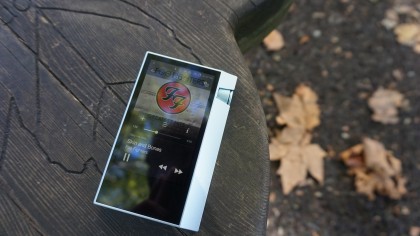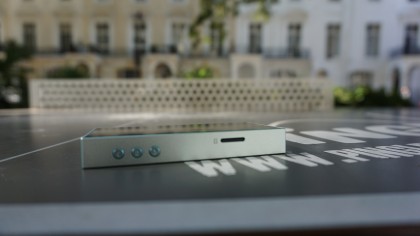TechRadar Verdict
It's a question of priorities here. The Astell&Kern AK70 offers phenomenal sound quality, but in doing so it jettisons some of the additional features offered by a typical smartphone, such as access to streaming services and decent Bluetooth connectivity.
Pros
- +
Amazing Hi-Res performance
- +
Dedicated media controls
- +
Slick interface
Cons
- -
Poor Bluetooth performance
- -
No support for streaming services
- -
Unresponsive volume control
Why you can trust TechRadar
It's tough being a dedicated music player in 2016. Whereas 10 years ago most music-lovers would rather die than leave their homes without their iPods or Zunes (remember those?), nowadays most people are happy with the sound quality offered by their phones.
And that's not because their standards are getting lower – it's just a fact that nowadays phones are pretty damn good music players. They offer an interface that's intuitive and familiar, and can be connected to every music streaming service going.
So what can a digital audio player (or DAP as audiophiles have taken to calling them) offer you in this day and age?
Well, if the AK70 from Korean manufacturer Astell&Kern is anything to go by, it's all about packing your player with support for the highest-quality music files and more specialised listening equipment.

Design
Look at the exterior of the Astell&Kern AK70 and you can immediately see a couple of reasons to stick with a DAP over your smartphone.
On the right side is a nice big volume knob, and on the left side are three buttons, two for skipping tracks and one for playing and pausing.
The left side of the device also houses the microSD slot, which can add up to 200GB of storage to the device's built-in 64GB.
Sign up for breaking news, reviews, opinion, top tech deals, and more.
On the bottom is a single micro USB port, which is used for charging and getting music onto the device, and which you're going to have to use – because, despite running a modified version of Google's Android operating system, the AK70 doesn't support streaming from services such as Tidal and Spotify.
You can also use this port to connect an external DAC, such as the Chord Mojo – although to be honest, if you're going to bypass the device's internal DAC then I'd seriously suggest you save yourself some money by simply plugging that same DAC into your existing smartphone.
After all, the big selling point of the AK70 is its beefy internal Cirrus Logic DAC, which is a significant step above what you'll find in most modern smartphones.
This DAC means the AK70 supports music up to 24-bit/192KHz PCM audio, which is a big improvement over the iPhone's maximum of CD-quality 16-bit/44.1kHz.
If you think it's a shame to limit such a DAC to use on the road, you can also connect the AK70 to your computer's USB port and put it in DAC mode, to enable you to listen to your computer's music collection with enhanced sound quality.
You can even take this a step further by putting the device into 'Line Out' mode, which will enable it to act as an audiophile bridge between your computer and a set of speakers.
The final audiophile touch is a second headphone jack in the top of the device, which enables you to use a pair of balanced headphones with the player.

Balanced headphones offer a much higher volume contrast than their non-balanced counterparts, and if you have a pair of headphones that support this enhanced functionality then you should definitely use them; the difference is small, but there's no reason why you shouldn't go for it.
You could of course bypass the headphone jack entirely, and use a pair of Bluetooth headphones (this player supports aptX); although if my testing is anything to go by you might not want to bother with this player if it's wireless performance you're after – more on that later.
Performance
When conducting my tests I used a few different pairs of headphones to get a good sense of what the player was capable of. I used a pair of Beyerdynamic T51i headphones for my wired listening tests, a pair of Sennheiser PXC 550s for my Bluetooth tests and finally a pair of Pioneer SE-MHR5's to try out the balanced headphone port.
High-res music will allow you to get the most out of the AK70. A sample 24-bit/192kHz recording of Storms Are on the Ocean by Amber Rubarth really allowed the player to sing, with a rich, deep sound that was a pleasure to listen to.

Another sample track, this time a DSD 2.8MHz recording of Vivaldi's Concerto in D minor, revealed the detail this player is capable of, with the multiple layers of string instruments effortlessly interacting without crowding each other out.
The AK70 also supports aptX Bluetooth if you want to connect a pair of wireless headphones. Most audiophiles will likely balk at the thought of putting their music quality in the hands of a Bluetooth codec, but the option is there for those who want it.
It's a good job that not many will use this player over Bluetooth, because I found its performance in this regard to be absolutely shocking. The connection was very insecure and flakey, and would regularly crackle mid-track.
I initially thought the problem might be down to me having the player in my back pocket, but switching it to my front pocket didn't improve things at all.
In fact, the only time when I was able to get an acceptable level of Bluetooth performance was when I was listening to the AK70 with wireless headphones while it was on a desk in front of me.
When doing so you'll find that the player's wireless performance is adequate, although you should note that in this configuration your sound quality will depend more on your headphones than on the player.
The player sounds great when used with a pair of wired headphones, however, and even purrs if you offer it a standard 16-bit/44.1kHz recording for it to sink its teeth into.

I spun up a guilty pleasure of mine, Lounge Act by Nirvana, just to hear how the AK70 dealt with one of the band's funkiest bass lines. It didn't disappoint – the bass was clear and distinct throughout, even when Kurt Cobain's guitar and vocals get especially pained towards the end of the track.
The AK70's interface is basic but functional. It's easier to find tracks by scrolling through your library than by searching, due to the small screen necessitating an on-screen keyboard that's cramped to type on.
Additional options are accessed, in typical Android fashion, by swiping down from the top of the screen. From here you can choose to connect wirelessly via Bluetooth or Wi-Fi, which is simple enough, although I found that I had to position the player closer to my router to allow it to download a firmware update without incident.
Given that I experienced issues with both the Wi-Fi and Bluetooth performance, I've come to the conclusion that the AK70's entire wireless performance is lacking. Outside of the occasional firmware update most people probably won't ever need to connect wirelessly (especially since the included Groovers+ app is currently limited to Korea), but it makes the product feel much less premium than its price tag suggests.
While we're on the topic of the player's interface, I also felt the dedicated volume control was a little unresponsive. I appreciate that you might not want to accidentally turn the volume all the way up when you put the player in your pocket without locking it, but the lack of responsiveness of the wheel made me resort to using the on-screen volume control on more than one occasion.
As a final test I gave Best of You by the Foo Fighters a listen. The sheer amount of detail packed into even this CD-quality track is immense; I particularly loved the extra sparkle in the mids given to the twinned guitar lines.

We liked
Make no mistake, your music will sound incredible when played through the Astell&Kern AK70. From high-res right down to standard CD-quality, every track I played through the player sounded magnificent, and it was great to have the option of plugging in balanced headphones to boost the sound quality even more.
Dedicated music playing buttons on the exterior of the device also make it easy to control your music without having to turn on the screen, or even take the player out of your pocket, although I personally wish the volume knob was a little more responsive.
It's also nice to have the option of using the player as an external DAC for your computer or laptop, although I found that it was a little flakey when it came to drivers.
We disliked
Don't buy this player if you intend to listen to music over Bluetooth – it's not worth your money.
The interface is slick and responsive, but it's a shame that it's not easier to search for tracks to listen to, and I also disliked that the volume dial (which should be a big selling point on a music player like this) was less responsive than your average smartphone volume rocker.
Verdict
If sheer music quality is your aim, then the Astell&Kern AK70 is a phenomenal-sounding beast. If that's all that matters to you then there are few downsides to this player.
But if you want a more versatile machine that can power some wireless headphones, or perhaps stream from the likes of Spotify or Tidal, you might be better off investing in a decent external DAC for your phone, which is likely to offer a better jack-of-all-trades experience.

Jon Porter is the ex-Home Technology Writer for TechRadar. He has also previously written for Practical Photoshop, Trusted Reviews, Inside Higher Ed, Al Bawaba, Gizmodo UK, Genetic Literacy Project, Via Satellite, Real Homes and Plant Services Magazine, and you can now find him writing for The Verge.
